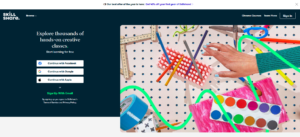Since the pandemic broke out at the start of 2020, the adoption of new technologies has accelerated tremendously. So, as Zoom replaced in-person meetings and pajama pants replaced trousers, it was only natural that learners would seek a digital avenue, as well.
Online learning has soared in adoption these past few years, and the growth is driven by more than the pupils and students who began taking their classes online. The e-learning sector has been up and coming for quite some time, and it turns out that the pandemic was just the nudge it needed to completely explode.
In 2020, the global e-learning market surpassed $250 billion. That same year, Coursera, one of the biggest players in the game, saw a 66% growth of new users while EdX, its main competitor, boasted a stunning 161% YoY member increase. In fact, forecasts place the CAGR of the whole sector at 21% between 2021 and 2027.
How the E-learning Business Model Works
Given the monetization opportunities this market shows, it’s only natural to wonder how the e-learning business model works. Here are several of the most popular online learning formats:
On-demand E-learning
Today’s world presents itself with awesome opportunities at every turn, so much so that balancing a busy schedule of professional tasks, family time, and personal growth can prove to be a daunting task. Nowadays, learners, like any other modern consumers, are burdened with the usual “places to go, people to meet” framework. That’s where on-demand e-learning comes into the picture.
With on-demand e-learning, enrolled users can fire up their courses pretty much anytime and anywhere it’s suitable for them and start studying. This is also highly advantageous for providers since they can simply create the product once (the digital copy of the course), and distribute it endlessly, obtaining maximum returns.

Subscription E-learning
Like its on-demand counterpart, the subscription model provides ease of access tailored to the availability of the consumer. The difference from the previous model lies in its financing. In the on-demand e-learning model the customer pays per course, whereas the subscription model – as you might guess– implies a necessary recurring payment from the consumers.
E-learning Measured Against Classical Models
There are numerous reasons why today’s consumers may favor an e-learning approach versus traditional education. E-learning frees users of the headaches of commuting, managing a schedule, and even having to put on appropriate office attire. At the same time, educators are no longer confined to teaching to a limited group of individuals at a singular time and can generate their customer base pretty much indefinitely.
Of course, there are some aspects of the classical learning model which make it more ideal in some industries. Some subjects, especially those of a more physical nature (like woodworking, rock climbing, or wine tasting, for example) might not be as suitable for e-learning as the theoretical ones.
However, with the advent, development, and growing adoption of technologies such as virtual and augmented reality, it’s highly plausible that these subjects will become accessible as well, causing consumers to shift their preferences. In any respect, the e-learning sector is a safe bet when it comes to future growth.
Growth Strategies for E-learning Success
By now you’ve probably formed an impression about the industry, how it works, its benefits, and the tremendous opportunities that can arise in this sector in the future. However, you’re likely still far from knowing exactly how to start a successful e-learning business.
To gain more in-depth knowledge, let’s further explore the most important aspects of growing your e-learning solution.
Importance of Global Capabilities and Localized Experience
The growth potential of your e-learning business greatly depends on the scale of your operations and on your ability to localize the learning experience. Since the limits of your audience can expand exponentially, why shouldn’t they? Around 1.35 billion people worldwide speak English while slightly more than 1.12 billion are Mandarin Chinese speakers. Add Hindi and Spanish to the math with totals of 600 and 543 million speakers respectively and you’re very close to covering half of the world’s population.
This all stresses that, while expanding globally is essential for this business type, success comes faster for those who localize the learning experiences. This goes beyond simply adapting the language of the subject matter, as there are many additional aspects to cover to really obtain a native feeling.

Payments, Checkout, and Onboarding
The way your users experience your online course can make the difference between a successful business and a struggling one. Friction points in the user journey can seriously harm your funnel, and it all starts with onboarding.
That’s why offering a localized experience throughout their onboarding journey is paramount. This will help not only in allowing the customer to seamlessly finish their purchase but will solidify their trust in the e-learning platform.
Besides a friendly and familiar interface, it is just as important to provide local currencies and locally preferred payment methods as means of finalizing the transactions. After your users have succeeded in purchasing the course, it’s important to have automated onboarding flows in place. Use email campaigns and in-app notifications to get users to try platform tutorials, return to the course at certain intervals and, overall, to guide them to experience the promise of your product within a short time.
Trial Strategies
Offering free trials is an excellent tactic to get your first course sign-ups, allowing users to experiment the product before committing to a purchase.
With digital products, especially in SaaS, free trials are like the test drive that seals the deal after you fall in love with the car from behind the wheel. Be advised, though, that it may take some experimentation before you decide on your free trial approach.
First, trials can be offered with or without the requirement to input a credit card. This makes a big difference, and both approaches have their advantages and shortcomings. Asking for a credit card before the free trial may deter those prospects who aren’t ready to commit, but it also introduces some friction in your flows which might lose the business some serious leads as well. Offering a free trial without a credit card may convince more users to sign up, but retaining them might be harder as their usage is not rooted in a financial commitment.
Try experimenting with different free trial lengths (7 versus 14 and 30 days) to understand how much time your prospects need to grasp the utility of your learning program. Also worthy of exploring is offering the first lesson in a course for free, to generate interest in the curricula and the teaching format.

Source: Skillshare
Freemium strategies could also be worth exploring. Consider offering one or two lighter courses as forever free on your platform, which will attract interest, while conditioning access to your complete e-learning offerings via a paid subscription.
Of course, some business models simply aren’t suitable for freebies, since too many casual shoppers can dangerously impact the bottom line. In such instances, a paid trial can be used instead.
Customer Engagement
So, you’ve scaled your customer base indefinitely, hooked in your audience with tailored localized experiences, gotten them to sign the dotted line after a well-executed trial strategy, and have gained their trust (and money). Although everything is working great so far, the most critical part is about to start.
Customer engagement is the most crucial element of any e-learning business, and it absolutely is the lifeblood of your operation. Without being engaged, customers won’t use your product and will simply stop paying for it. Planning for, executing, and measuring engagement are mandatory processes that will bring in the most results in terms of business growth. Set up your flows so that users have periodic reminders about the course they’ve signed up for. Email reminders and teasers, in-app/platform notifications, and feedback surveys go a long way in keeping users around and engaged with your course.
Retention Strategies
Some common retention strategies will include price optimization, upsells and cross sells, rewards programs, and strategic placement of offers and discounts. While all these can and will work in some respects, and must be included, they are missing the main point. As with anything in business, it all gets down to knowing your customer and meeting their expectations to a T or as close as possible. Sure, churn is inevitable, and some clients will leave no matter what. However, implementing the right practices will guarantee that many more customers will fall in love and stay.
In e-learning, having your client succeed is essential. When we were in the traditional school setting, we may not have succeeded in every subject or two, but we likely had no choice but to continue. If you want to succeed in this business, your customer must feel like they’re winning so they don’t drop out.
Retention requires ongoing product efforts and continuous optimization of customer touchpoints. Creating courses and learning models that excite and hook the student and make them happily pay month over month is a holistic process. Everything matters, including having interesting teachers, well-structured courses, and engaging exercises.
Your processes also come into play, as they help shape the customer’s experience. Communicate often and transparently with users, so they always know what’s coming up in the course. Notify them of upcoming work, but also of administrative aspects, like when their next recurring payment is due. Advertise features that can simplify the whole process for your users. Give them the option to automate payments with auto-renewal campaigns. Offer pause subscriptions features to customers who are thinking of taking a break from learning. Periodically assess their feedback with in-product surveys. As we’ve already stressed, it’s essential that know your customer well.

Data Analytics
Data is the missing link between common anecdotal knowledge and factual reality, and provides the information you need to know everything about your target audience. A subscription e-learning model gives you access to all types of usage and financial data, thus allowing you to make faster business decisions and optimize the experience. Tracking essential metrics like monthly recurring revenue, growth rate, customer lifetime value, churn rate, and customer acquisition cost will shine a light on how you fare in terms of profitability. Tracking metrics like number of hours spent in the learning platform, most-often-viewed categories, or the number of key actions the user takes during the course will help you understand how students are experiencing the learning process.
Nowadays, big data is essential. Your competitors are doing it already and without it, you’ll be knocked out of the game in no time.
Learning Management Systems (LMS) – What Functionalities You’ll Need
LMSs are just like content management systems, but for learning. (Think WordPress but dedicated to hosting online courses.) Although these might seem complex, you’ll be amazed by how little you can get away with, if your resources are limited. In fact, e-learning business start-ups or small companies can even opt for one of the many free open-source systems available.
As with everything, paid tools will provide much more functionality beyond the basics. The bare minimum required is a user-friendly interface with a responsive design that also provides most if not all learning resource types (pdfs, images, videos, and audio files).
Beyond this, top LMSs provide automated studying journeys for the customer, social learning experiences so they can share their progress with their peers, and personalized UI and data tracking. Meanwhile, on your end, you absolutely must consider the scalability of the platform you choose and how it fits with your plans.
All in all, e-learning is a highly lucrative and rewarding business, with many opportunities for merchants working in this field. There might never be a better time to get involved. If you’re on the fence about jumping in, we hope our article has shed some light on the industry. We wish you good luck with your e-learning business ideas!
For more details on how to start an eCommerce business, be sure to read our step-by-step, comprehensive guide here.






